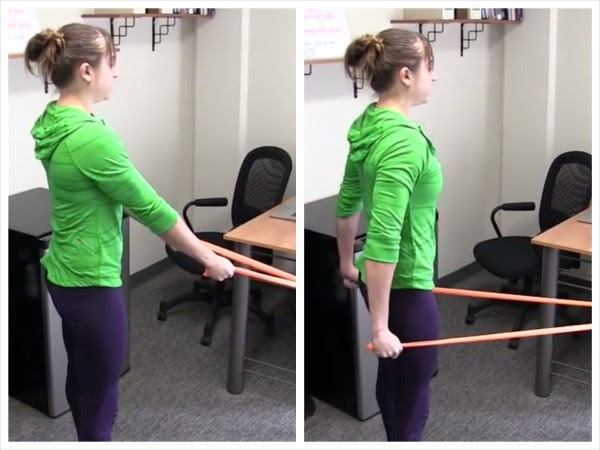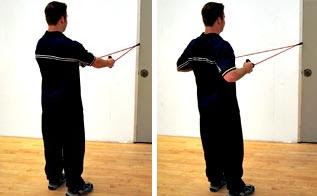As you can see, the shoulder joint is shallow. Think of a pool ball next to a tea saucer. This give the shoulder a large amount of freedom of motion but it also can make it unstable. It fully relies on a network of muscles to give it stability and strength throughout a large range of motion.
Category Archives: arm
The Shoulder
 Few joints are as multipurpose as the human shoulder. We can walk on our hands, crawl and do push ups. The shoulder is a very sturdy join. Yet no joint in the human body is as mobile. Known as a “ball and socket” joint, the shoulder is essentially a pool ball freely rotating in a tea cup saucer. This allows for free rotation of the arm in all directions. You can literally wave your hands and arms in perfect, large circles as though they were helicopter blades. In comparison, your knee only folds and straightens. It is called a hinge joint for that reason. Even your cervical spine (neck), which does allow for tremendous free movement, does not have as much range of motion as the famous shoulder joint. Continue reading
Few joints are as multipurpose as the human shoulder. We can walk on our hands, crawl and do push ups. The shoulder is a very sturdy join. Yet no joint in the human body is as mobile. Known as a “ball and socket” joint, the shoulder is essentially a pool ball freely rotating in a tea cup saucer. This allows for free rotation of the arm in all directions. You can literally wave your hands and arms in perfect, large circles as though they were helicopter blades. In comparison, your knee only folds and straightens. It is called a hinge joint for that reason. Even your cervical spine (neck), which does allow for tremendous free movement, does not have as much range of motion as the famous shoulder joint. Continue reading
Do-It-Yourself Shoulder Rehabilitation
If you have gone to your doctor, chiropractor or physiotherapist and have been diagnosed with a shoulder strain (i.e.: rotator cuff strain, impingement syndrome, etc) but you have been confirmed that there is no tearing of your tissues, you can perform the program below three times per week for 3 to 4 weeks to see how much progress you can make.
Most shoulder strains are the result of weak shoulder girdle muscles. That is, the muscles that attach your shoulder blade to your thorax, when weak, cause the shoulder blade to move too much whenever you move your arm. This increases the wear and tear in the shoulder joint. Further, the rotator cuffs are also usually too weak in patients who have mild to moderate shoulder strains. The job of the rotator cuffs is to anchor your arm bone to your shoulder socket (which is on the shoulder blade).
So, by firming up both the shoulder blade’s stability and the firmness of the arm’s connection to the shoulder blade (via rotator cuffs), you are improving the way the kinetic chain of the whole arm functions. Think of it as “core exercises” for the shoulder and arm. Your strength will increase and your pain will decrease.
_________________________________________________________________________
EXERCISES
External Rotations
– grab theraband with hand of the affected shoulder, place magazine between elbow and side.
– Head back, chest out, pinch shoulder blades together tightly.
– Elbow bent 90 degrees.
– Start position is with forearm sticking straight forward (perpendicular to theraband).
– Keeping proper form, externally rotate shoulder as far as you can.
2 set of 12-15 repetitions.

______________________________
2. Jack Hammers (speed drill):
– stand facing door where theraband is anchored
– grab each end of theraband with both hands
– standard posture
– keep elbows slightly bent, start with hands next to hips
– with straight arms, pull hands as far back as you can, return them no further than hips (unlike pic)
do as fast as you can for 30 seconds. Rest. Do it once more.

3. Theraband Rows at 45 degrees
– anchor t-band around doorknob
– grab each end of the t-band, standard posture
– relax shoulders and pinch shoulder blades together
– row back as far as you can
2 sets of 15-20 repetitions

Tennis Elbow
 Elbow pain is a common issue with patients who play racquet sports or who have jobs requiring repetitive wrist and hand motions (e.g.: electricians, carpenters, etc). If the pain is on the outside of the arm near the elbow, you may have “tennis elbow” (a.k.a. lateral epicondylitis).
Elbow pain is a common issue with patients who play racquet sports or who have jobs requiring repetitive wrist and hand motions (e.g.: electricians, carpenters, etc). If the pain is on the outside of the arm near the elbow, you may have “tennis elbow” (a.k.a. lateral epicondylitis).
Muscles that move the hand and wrist backwards are anchored near the elbow on the lateral epicondyle.
So if forcefully moving the wrist backwards (as though revving a motor bike) hurts the outside portion of the elbow region, your tennis elbow diagnosis is more likely.

You may also want to refer to our flow chart**:

HOME THERAPY
If you believe you may be suffering from tennis elbow (i.e.: lateral epicondylitis) try the following approach:
- Do not perform activities requiring repetitive grasping, lifting or rotating of the hand/wrist
- if you are healthy, take ibuprofen daily for 4 straight days
- first thing in the morning, apply hot pack to elbow region for 10 minutes
- in the evening perform a contrast therapy session:


If one week of the above protocol does not significantly decrease pain, see your chiropractor or physio for more aggressive clinical treatment.
**always see a professional for significant pain, this blog post is meant to be a guide for patient education and does not encourage you to self diagnose.


